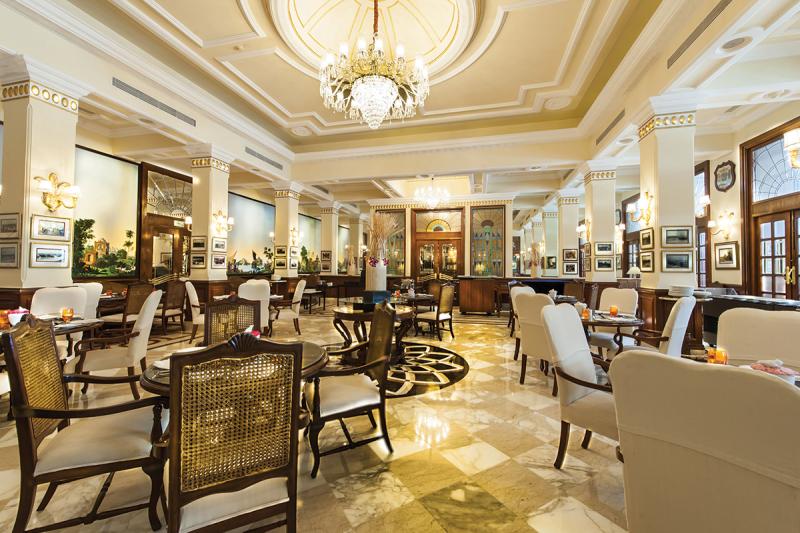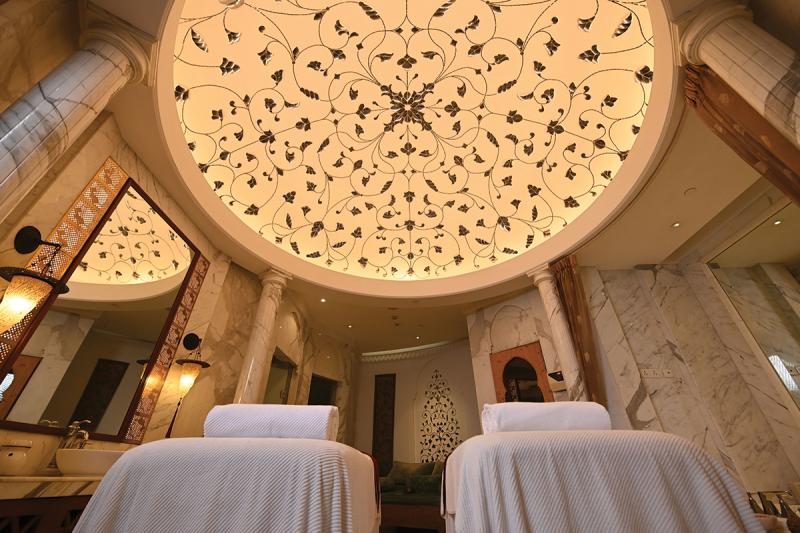Located on eight green acres a short walk from the city’s center point, Connaught Square, and half an hour from the airport, The Imperial was Delhi’s first hotel when it opened in 1931. Today, it is as luxurious and steeped in heritage as it was back then, and it still belongs to the same family.
In the early 2000s it got a makeover that preserved its historical allure while adding contemporary touches and new features like the spa, which is in a Mughal-style pavilion in the landscaped gardens. The hotel is a member of The Leading Hotels of the World.
We were greeted by a Sikh doorman wearing a traditional white tunic and a magnificent red turban. It felt like stepping back into the days when Maharajas ruled the land.
Inside, we found even more history. As a smiling front desk associate welcomed us with a traditional red tilaka (dot on our forehead), we stepped into a space where every wall—in the lobby, hallways and all 235 guestrooms and suites—was adorned with artwork. There are over 5,500 of them, making it the world’s largest private collection of Indo-European paintings, lithographs, photographs, sculptures and artefacts. It’s also a great way to catch up on India’s storied past.
The rooms and suites start from the Deco Rooms, which measure 285 square feet and have Atrium views, while the 4,000-square-foot Imperial Suite is truly fit for a king. Decorated with opulent antiques and Persian rugs, it has a magnificent verandah lounge with silver furniture and marble sculptures, a master bedroom with a study, a walk-in closet, a dressing room and a bathroom equipped with steam, sauna and Jacuzzi facilities. All guests are taken to their rooms by a member of staff, but those in the Heritage, Deco and Luxury Suites enjoy access to the Imperial Lounge for personalized check-in, as well as breakfast, cocktail hour and all-day tea and coffee.

Rooms have marble or parquet floors, dark wooden furnishings and marble bathrooms, and many of the Imperial and Heritage Rooms—which are among the largest in the city—are connecting. The Grand Heritage Rooms have an open-plan living space and garden views, and the four Luxury Suites have four-poster beds, a living room and 24-hour butler service. Good to know: Butler service can be extended to the Deco, Heritage and Viceroy suites for an additional cost.
The most popular are the 72 Imperial Rooms, which should be booked at least a month ahead, especially for the peak months of October to March. Sending VIPs? Contact Prabhneet Kaur Sodhi (pksodhi@theimperialindia.com) who looks after guest relations, liaising with Louis Sailer, senior executive vice president.
The 1911 restaurant serves international and Indian dishes from breakfast through the day, with alfresco dining in the garden. Executive Chef Philippe Agnese (pagnese@theimperialindia.com) told us his signature dish is the mega Imperial Schnizel. It is made with chicken not veal, because in India, beef is not on menus as Hindus, who make up most of the population, do not eat it for religious reasons. Top tip: If you have clients who are into history, make sure to reserve the white marble table with heavy wrought-iron chairs. It was at this table that history was made when Mahatma Gandhi, India’s first Prime Minister Jawaharlal Nehru, Muhammad Ali Jinnah of Pakistan and the last English Viceroy Lord Mountbatten, sat down to discuss the partition of India.
The Spice Route restaurant took seven years to hand-paint, and the result is as astonishing as the curries and spiced seafood dishes from southern India on the menu, together with Thai, Vietnamese, Malaysian and Sri Lankan specialties. We loved the muted lighting and the heritage mood. The service was top class, and there are also vegetarian and vegan choices on the menu.
We live in Italy, so when traveling, we try to avoid Italian restaurants, but we did try the San Gimignano for lunch. And what a surprise! Our pizza and Parma ham were of exceptional quality, even by Italian standards. The pizza was as light as air and the al fresco, sun-drenched terrace felt like being on the Amalfi Coast. The Atrium, with its abundance of natural light, is a glass-domed courtyard that serves light meals, cocktails and the Imperial’s traditional Afternoon Tea, which is served on the finest china, with a selection of teas and a lavish buffet of sandwiches, quiches, pastries and cakes.

The Imperial Spa and Salon offers holistic and traditional treatments. It features Hammam and hydrotherapy facilities, as well as a large and luxurious Moghul Suite for couples, complete with en-suite steam, sauna and Jacuzzi facilities. The spacious pool offers an ideal spot to unwind after a day of sightseeing or shopping. Attentive staff provide chilled towels, refreshing water, and serve snacks and cocktails for the ultimate relaxation experience.
New Delhi must be explored in depth and Head Concierge Kamaal Abbasi (concierge@thaimperialindia.com) is the person to contact for arranging exclusive experiences and resolving logistics. He gave us valuable insight into local shopping. We started on Janpath, right beside the hotel, at the Tibetan Market where we found more touristy stalls and shops selling Indian handicrafts, clothing and jewelry.
Kamaal also recommended the Khan Market, which is a mix of brand stores and Indian labels. We checked out Sadarji’s for high-end shawls and scarves; People Tree, which uses natural fabrics for stylish fashions, and Anokhi for eco-friendly, handcrafted home décor items like bed linens, cushion covers and tablecloths. For out-of-house dining, Kamaal suggested The Art of Dumpling, which has an eye-opening choice of dumplings—the menu states 99. The atmosphere and the menu are Pan-Asian, and the dumplings were really delicious.
Related Articles
On Site Report: The Oberoi, New Delhi
Experiencing Delhi Like an Insider